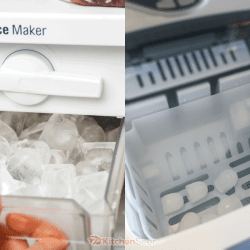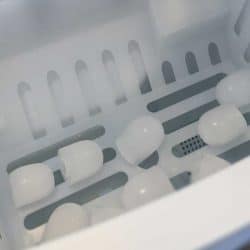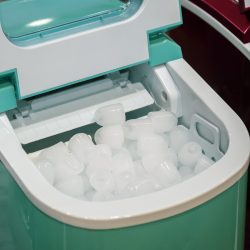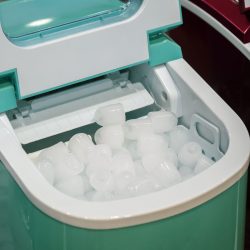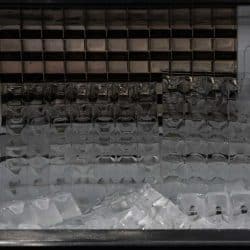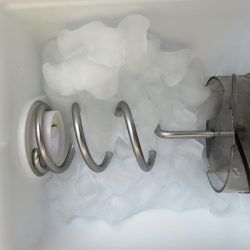Portable ice makers allow you to have an unlimited supply of bullet or cubed ice. You're on the right page if you are wondering whether you can leave your portable ice maker on all the time, or if you should turn it off. To help you, we researched the best thing to do. Here's what we found.
You do not need to turn off your portable ice maker. With the help of security features or a mobile application, you can leave it running for 24 hours like a refrigerator.
In this post, we present a detailed discussion covering the use of a portable ice maker. We will also explore its maintenance, electricity consumption, troubleshooting, and other concerns. So please keep reading while enjoying your ice-cold beverage.
![close up photo of a portable-mini-ice-cube-maker many ice cubes green colored ice maker portable, Should You Turn Off Your Portable Ice Maker [Or Can You Leave It On All The Time]?](https://kitchenseer.com/wp-content/uploads/2022/09/Should-You-Turn-Off-Your-Portable-Ice-Maker-Or-Can-You-Leave-It-On-All-The-Time-visual.png)
Can I Leave My Portable Ice Maker On Overnight?
You can opt to leave the ice maker overnight or all day. However, if your ice maker will run for a longer duration, ensure it has enough water.
Many homeowners prefer to collect a bunch of ice and place it inside the freezer or cooler at night, allowing them to turn off the appliance.
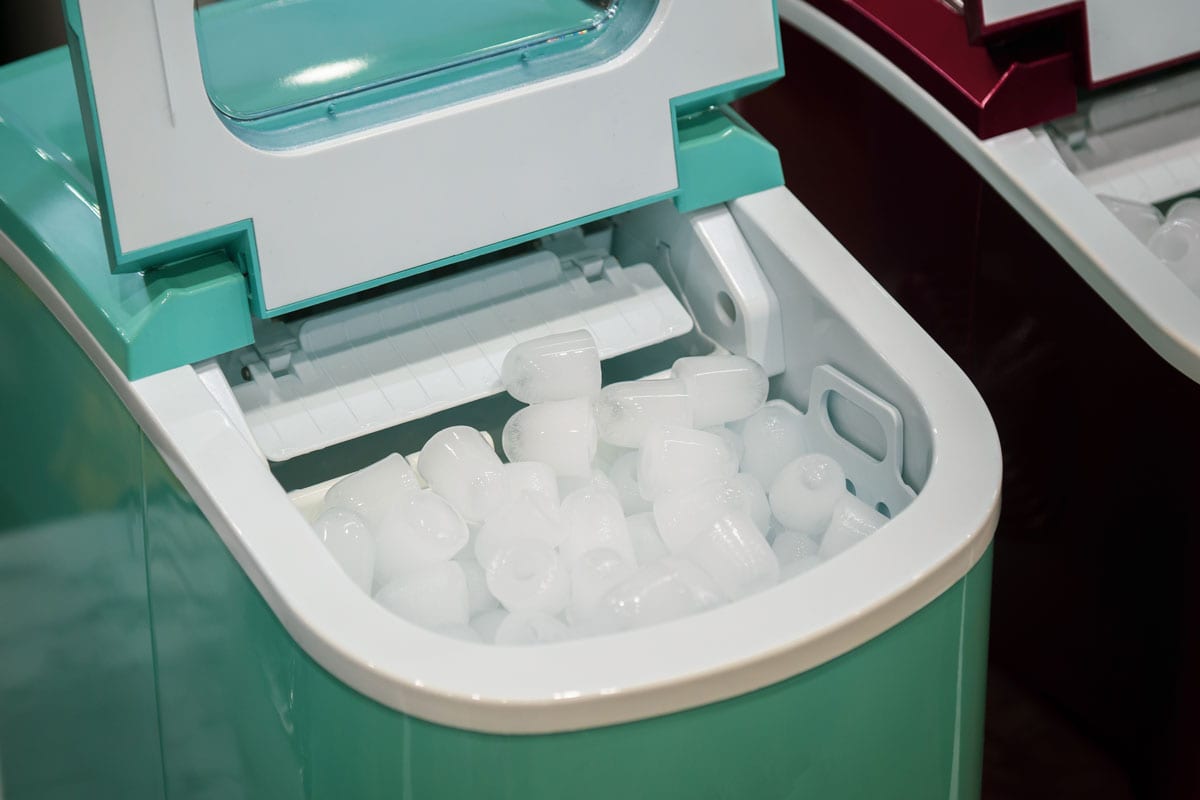
In addition to your preference, remember that the ice maker needs electricity to function. The more you use it, the greater the energy intake. You can turn off the unit for a lower cost on your electric bill.
Do Ice Makers Turn Off Automatically?
An adequate water tank is crucial for your ice makers' performance. Despite the compact size, a few units can hold at least 3 quarts of water, making them ideal for 24-hour use.
For this reason, you must fill it every day. Otherwise, the machine will stop working because of the insufficient reservoir. In other words, it will immediately shut off for the safety of its users.
Thus, it is best to turn off the unit if you are going out of town or won't need ice for a while.
Click here to see this automatic ice maker on Amazon.
Do Portable Ice Makers Use A Lot Of Electricity?
The electricity consumption differs depending on the brand and make. Other factors, such as production capacity and hardness, affect the ice makers' energy efficiency.
On average, the popular ones operate from 150 to 300 kilowatts per hour monthly, adding up to $20.
Similarly, they require around 119 voltage and 2.5 amps to function well. Although Energy Star only certifies the automatic commercial versions, the portable ones will still contribute less to your bill.
It is because they can only produce between 26 and 40 pounds of ice daily compared to 500 pounds from the former.
How Do You Shut Off A Portable Ice Maker?
Press the button labeled "On/Off" or "Power" to shut off a portable ice maker. As a result, the power indicator lights are unlit.
With some units, you can also do this through your smartphone. Other brands have mobile applications working as remote controls. Remove the cord to disconnect it completely from the electricity if it remains unused for a while.
Why Isn't My Portable Ice Maker Getting Cold?
If the cycle works but ice is unavailable, then the room or water temperature is not within the recommended level. Try moving it to a shaded area.
Other culprits are leakage of the refrigerant liquid and obstructed cooling system pipes. Get a certified HVAC technician to help you in these situations.
Similarly, check how long the time lapsed following the last cycle. Unlike compact freezers, a portable ice maker cannot maintain an ice cold state for several hours.
Ice cubes will circulate back to the water tank after melting for another cycle because of the heat exchanger.
An ice machine will also stop working under hot conditions. In contrast, the prolonged freezing process can cause cubes to stick together. Ice making is noisy, and this is normal because of the dumping of the ice.
How Long Does A Portable Ice Maker Last?
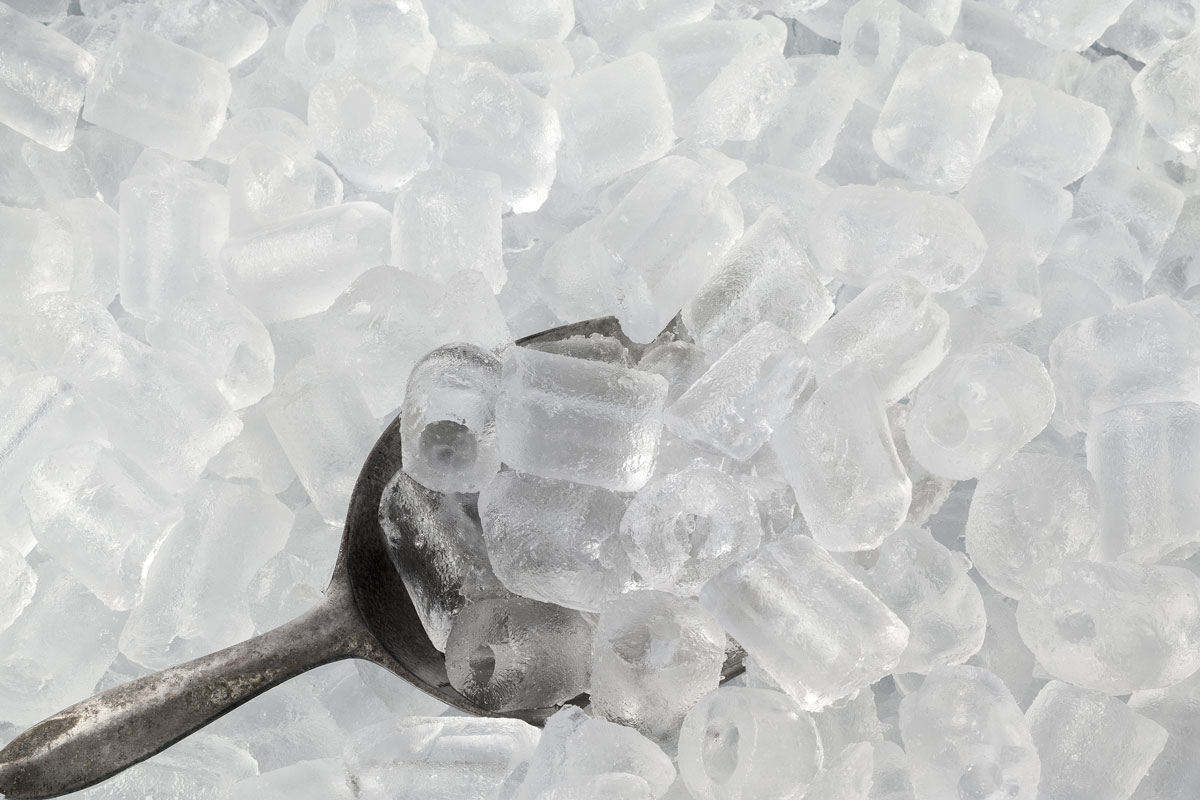
Portable ice makers last between four and 10 years. While the ice-making cycle occurs between six to 13 minutes, constant use throughout the day leads to normal wear and tear after several years. It can cause internal problems.
Generally, manufacturers offer a one- to three-year warranty upon purchasing the appliance. This is beneficial when you encounter factory defects.
When a machine can't be repaired, you can purchase a new one. You can extend its lifespan with proper care.
Maintenance Tips
We collected different ways to attain a long-lasting and energy-efficient portable ice maker.
- Add cold water to speed up the cooling process of the compressor.
- Place the unit under a canopy or away from direct sunlight.
- Perform regular cleaning.
- Keep the vents free from any blockages (two-inch clearance at the back)
How Do You Use A Portable Ice Maker?
Portable ice makers are straightforward to use. Similar to air conditioners and refrigerators, they have prongs filled with refrigerant to freeze the liquid.
For this reason, you will not need much time or special skills to get ice bullets for your drinks.
Most machines do not require water and drain line hooking or other installation. Here are the six typical steps you should follow, regardless of the brand.
- Switch on the unit.
- Pour clean, potable water into the tank.
- Select the preferred size of ice.
- Take note of the alarm signal marking that the ice bucket is full.
- Open the basket and scoop the ice into your glass or pitcher.
- Set the frequent purification cycle.
What Is The Best Water To Use In A Portable Ice Maker?
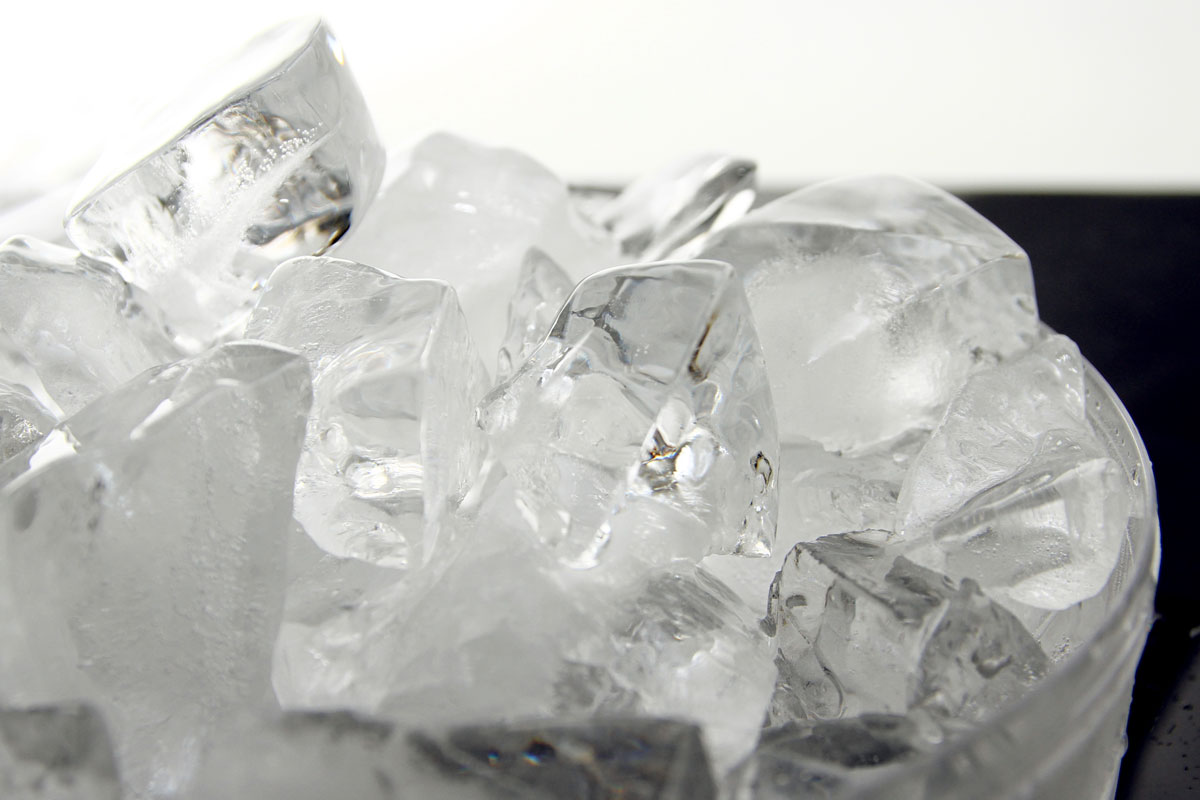
Distilled water is the preferred option for use in a portable ice maker. It is clear from mineral deposits like calcium and magnesium. However, the machine's sensor cannot always identify purified, filtered, and distilled liquids.
Thus, some manufacturers recommend adding a dash of salt to the potable water to make it detectable. A pinch of salt will not impact the taste of the water. The ideal temperature ranges from 51°F to 90°F.
Are Ice Makers Safe?
Ice makers are safe for everyday use, provided you practice regular maintenance. Like any electrical appliance, outlet and wiring are potential hazards, so you should ensure they are in good condition before operating the unit.
Here are some precautionary measures to prevent accidents:
- Keep the machine away from flammable materials and children's reach.
- The unit is not suitable for outdoor use.
- Do not create ice from any liquid except potable water.
- Avoid plugging it into an extension cord.
- Place it on a flat surface.
- Keep it unplugged when repairing or washing.
- Keep the unit clean.
When Should You Clean Your Portable Ice Maker?
Cleanliness affects every machine's efficiency. Ice quality depends on how well you take care of a portable ice maker.
You should schedule the regular cleaning of your appliance every three months, especially if you use it often. It's time for cleaning when you notice these telltale signs.
- Gives off a nasty smell
- Leaves an unexpected taste of ice
- Carries visible dirt around interior walls
- Produces smaller tube ice compared to the expected size
- Allow the ice to melt faster than usual
- Appears cloudy instead of clear
- Deteriorate overall functions
How Do I Clean The Inside Of My Portable Ice Maker?
After several cycles, your portable ice maker will develop limescale buildup. It is a chalky and stubborn stain when the water dries. Mold and bacteria love to breed in this machine because of its moist nature.
Although some models have an automatic cleaning function, a manual wash is still essential. Use a cleaner with a non-toxic, odorless formula. To make your unit sparkle, follow this procedure.
- Unplug the unit.
- Mix the descaler with water. Follow the suggested amount on the label's instructions.
- Pour the solution into the reservoir.
- Create ice cubes out of the mixture and discard them.
- Repeat Step 4 at least three times.
- Set another round, but this time use pure water to rinse out. Throw away or repurpose this batch.
- Sanitize the ice scoop.
- Wipe the exterior and interior surfaces with a damp cloth.
Note that some ice makers feature a removable drain tray for easy wash. Discard the remaining liquid if present.
Click here to see this ice machine cleaner on Amazon.
For more insights about taking care of this appliance, view this guide: How To Clean A Portable Countertop Ice Maker.
Can I Run Vinegar Through My Ice Maker?
You can run distilled white vinegar through your ice maker similar to the commercial machine cleaner. You may already have it in your kitchen. It is a practical solution for deep cleaning.
With its anti-bacterial properties, vinegar acts as a deodorizer and descaler of hard stains. Combine 10 portions of water for every part of the vinegar.
Final Thoughts
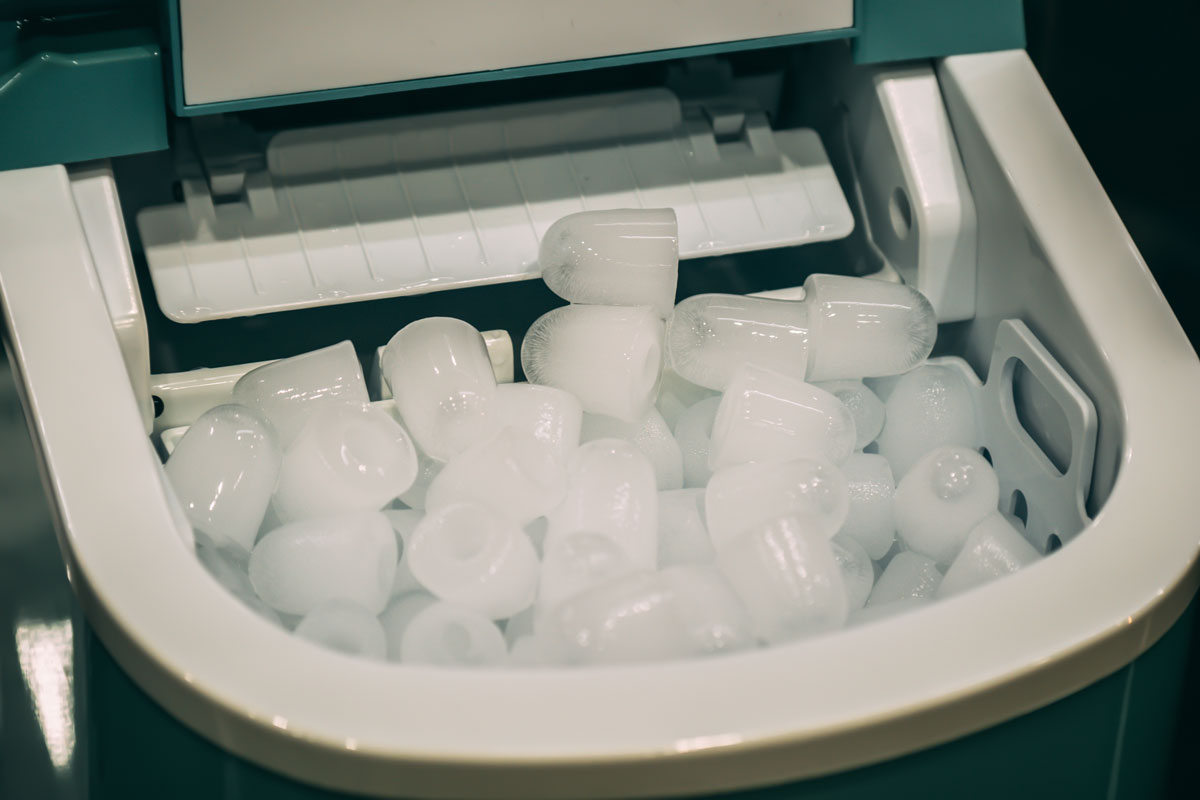
You can leave your portable ice maker running. However, the water tank should be at the optimal level for continuous operation. Remember to keep the unit clean to avoid health hazards and prolong its lifespan.
By taking these steps into consideration, you will never run out of ice for drinks, particularly during parties and camping activities.
Thanks for reading! If you enjoyed this post, explore these articles about ice makers:
How Long Does It Take For An Ice Maker To Make Ice?
3 Types Of Ice Makers And Machines



